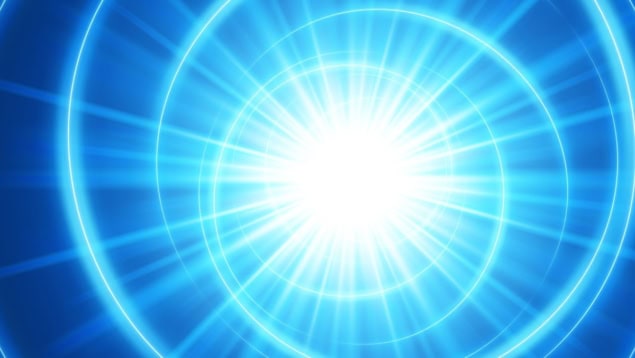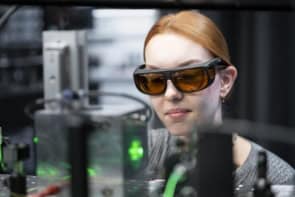
This article has been updated because the original version incorrectly claimed that the observed electrons follow “chiral paths” and “chiral trajectories”.
Structured electrons with chiral mass and charge have been created by researchers in Germany. The researchers say their work, which is analogous to work done with photons in 2010, achieves chirality in single-electron matter waves without angular momentum. Some other researchers, however, are puzzled by this claim.
In 2010, David Grier of New York University and colleagues created helical optical beams with much greater intensity at the beam edge than at the centre. Then, they showed that objects could be trapped by such beams and, depending on the chirality of the helix, pulled back towards the light source.
“At the time, we speculated that you ought, in principle, to be able to drop matter waves into one of these states,” says Grier. “People have controlled matter waves with light; they’ve created vortices in matter waves, but as far as I know no one has taken the next step and created not just a topological phase but a topological intensity distribution.”
Femtosecond electron pulses
In the new work, Peter Baum and colleagues at University of Konstanz fired femtosecond electron pulses (almost none of which contained more than one electron) from an ultrafast transmission electron microscope at a 50-nm-thick silicon nitride membrane. They directed optical laser pulses with orbital angular momentum at the same membrane.
The silicon nitride was transparent to electrons, but the laser pulses shifted the electron density in the membrane such that parts of the electron’s wavefunction were accelerated and other parts decelerated. This created single electrons with chiral mass and charge distributions. The researchers characterized these with a second femtosecond laser and silicon nitride membrane.
The team showed that, if they used laser pulses with zero angular momentum, the output could be modelled by electrons with no chirality. If the angular momentum quantum number was 1, the electronic charge and mass wavefunction has the chirality of a single, left-handed coil. If it was −2, the wavefunction was a right-handed double helix. They also scattered these chiral wave packets off chiral nanoparticles, with a left-handed electron showing less chirality when scattered off a left-handed nanoparticle and extra chirality when scattered off a right-handed nanoparticle and vice versa.
Imprinting chirality
The researchers explain that the optical pulses imprint chirality onto the electron’s wavefunction, converting it into a coil of charge and mass, without actually giving the electron either polarization or orbital angular momentum. “The coil propagates as a whole,” explains Baum; “the centre of mass is on a line.”
The researchers believe that these properties could be useful in a range of applications including electron microscopy, the study of magnetic materials, and construction of subnanometre optical tweezers. It could even, they say, have cosmological implications if such electron coils occur in nature. “Are they all around?,” ponders Baum, “We are currently starting to explore these possibilities.”
Grier is both impressed and puzzled by the results. “Light you can control essentially with consumer electronics,” he says, It’s much harder with matter waves. I consider this [work by Baum’s team] a really interesting implementation in matter waves of what my group demonstrated in 2010 in light waves.” He does note, however, that other groups have previously implemented chiral optical beams and shaped the intensity of electron beams, and that this research was not cited by Baum and colleagues in their paper in Science that describes their research. (Baum’s team accepts this and say they were unaware of the previous work.)

Twisted neutrons are created using a holographic approach
He is perplexed, however, by the researchers’ insistence that the chiral electron beams have no orbital angular momentum. He says that the chiral wavefunctions the researchers have achieved can generally be expressed as superpositions of so-called Bessel modes. “All but a special few of those superpositions carry orbital angular momentum through a net helical structure in the overall phase,” he says. “You have to do something a bit special to create a solenoidal mode with no orbital angular momentum. I don’t see how [Baum’s team] achieved that balancing act, or how they verified it. It seems to me that they just assume it to be so.”
Miles Padgett of the University of Glasgow in Scotland says that the research is “lovely” and says he “would happily accept that there is something interesting in generating an electron beam which goes above and beyond generating a solenoid optical beam.” He says, however, that “that’s not what [their] paper tells me, because this paper doesn’t recognize the generation of a previous optical solenoid beam [Grier’s work is not cited].” He is also puzzled by the claim of chirality without angular momentum, and is curious about whether or not the chiral electrons generate DC magnetic fields – which would indicate rotation. The researchers have not experimentally measured this.



